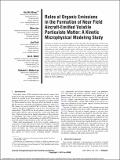Roles of Organic Emissions in the Formation of Near Field Aircraft-Emitted Volatile Particulate Matter: A Kinetic Microphysical Modeling Study
Author(s)
Wong, Hsi-Wu; Peck, Jay; Miake-Lye, Richard C.; Jun, Mina; Waitz, Ian A
DownloadWaitz_Roles of organic.pdf (3.105Mb)
PUBLISHER_POLICY
Publisher Policy
Article is made available in accordance with the publisher's policy and may be subject to US copyright law. Please refer to the publisher's site for terms of use.
Terms of use
Metadata
Show full item recordAbstract
A kinetic microphysical modeling approach that describes the formation of volatile aerosols in the presence of organic emissions in near field aircraft emitted plumes at ground level is presented. Our model suggests that self nucleation of organic species, binary nucleation of water-soluble organic vapors with water, and multicomponent nucleation of water-soluble organic vapors with sulfuric acid and water all have very slow nucleation rates. The formation of new homogeneous particles in near field aircraft plumes is thus considered to be driven by binary nucleation of sulfuric acid and water. Volatile organic vapors emitted from aircraft engines primarily contribute to the nucleation process by condensing on existing homogeneous aerosols and only affect the size and the composition (not the number) of the homogeneous aerosols. Our model also shows that under low ambient relative humidity levels or high ambient temperatures, nucleation mode particles are more organic-rich than soot coatings. Organic mass fraction of nucleation mode particles is more sensitive to organic emissions levels compared to that of soot coatings. Ambient temperature and relative humidity were also predicted to affect the nucleation of sulfuric acid–water cores, where higher ambient relative humidity level and lower ambient temperature strongly favor binary sulfuric acid–water nucleation. The effect of ambient conditions on organic fractions was predicted to be relatively insignificant.
Date issued
2015-01Department
Massachusetts Institute of Technology. Department of Aeronautics and AstronauticsJournal
Journal of Engineering for Gas Turbines and Power
Publisher
American Society of Mechanical Engineers
Citation
Wong, Hsi-Wu et al. “Roles of Organic Emissions in the Formation of Near Field Aircraft-Emitted Volatile Particulate Matter: A Kinetic Microphysical Modeling Study.” Journal of Engineering for Gas Turbines and Power 137.7 (2015): 72606. © 2017 The American Society of Mechanical Engineers
Version: Final published version
ISSN
0742-4795
1528-8919